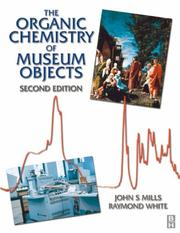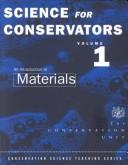| Listing 1 - 8 of 8 |
Sort by
|
Book
Year: 1959 Publisher: Amsterdam Intergrafia
Abstract | Keywords | Export | Availability | Bookmark
 Loading...
Loading...Choose an application
- Reference Manager
- EndNote
- RefWorks (Direct export to RefWorks)
Chemistry --- Graphics industry --- chemie
Book
Year: 2010 Publisher: Antwerpen Universiteit Antwerpen, Faculteit Wetenschappen, Departement Chemie
Abstract | Keywords | Export | Availability | Bookmark
 Loading...
Loading...Choose an application
- Reference Manager
- EndNote
- RefWorks (Direct export to RefWorks)

ISBN: 0750646934 Year: 2003 Publisher: Oxford Butterworth Heinemann
Abstract | Keywords | Export | Availability | Bookmark
 Loading...
Loading...Choose an application
- Reference Manager
- EndNote
- RefWorks (Direct export to RefWorks)
Museology --- Organic chemistry --- Conservation. Restoration --- museology --- organic chemistry --- museumkunde --- organische chemie
Book
Year: 1991 Publisher: Stockholm Riksantikvarieämbetet och Statens Historiska Museer
Abstract | Keywords | Export | Availability | Bookmark
 Loading...
Loading...Choose an application
- Reference Manager
- EndNote
- RefWorks (Direct export to RefWorks)
Chemistry --- Environmental protection. Environmental technology --- Conservation. Restoration --- weathering --- monumental stone

ISBN: 0415071658 041507164X Year: 1992 Publisher: London : Routledge,
Abstract | Keywords | Export | Availability | Bookmark
 Loading...
Loading...Choose an application
- Reference Manager
- EndNote
- RefWorks (Direct export to RefWorks)
Specialty chemical technology --- Conservation. Restoration --- Environmental protection. Environmental technology --- cleaning --- reinigingstechnieken --- Cleaning --- materials science --- preserving --- Chemistry --- chemistry --- restauratie (kunst) --- chemie --- restoration [process] --- Museum conservation methods --- Museum techniques --- Handbooks, manuals, etc. --- Conservation methods, Museum --- Contamination (Technology) --- Surface preparation --- Handbooks, manuals, etc
Book
ISBN: 9780750668316 0750668318 Year: 2011 Publisher: Amsterdam: Oxford: Elsevier, Butterworth-Heinemann,
Abstract | Keywords | Export | Availability | Bookmark
 Loading...
Loading...Choose an application
- Reference Manager
- EndNote
- RefWorks (Direct export to RefWorks)
Water is present when paper is made and when it ages. Water also serves many essential functions when deteriorated paper is treated by conservators. Drawing on paper industry and scientific research, Paper and Water examines closely the relationship between this common cellulosic material and H2O.The interaction between paper and water is a topic of primary importance for every conservator working with paper objects and other cellulose-based materials. Throughout the book, the theories that underlie the effects of water on paper, and their practical application, are presented in relation to the processes of conservation. Paper and Water is a reference and teaching compendium for conservation professionals involved in the preservation of paper objects in archives, libraries and fine museums around the world. Written by experts in paper conservation, this book and DVD aim to serve a rapidly expanding profession.The book includes :- integrated knowledge from disciplines of paper engineering, conservation science and conservation practice- hundreds of full colour illustrations to aid understanding- DVD featuring videos and animations, most of which exclusively produced for this book, and a selection of key illustrations from the book to support teaching
Book conservation --- Paper --- Water chemistry --- Cellulose --- Papier --- Eau --- Preservation. --- Chemistry. --- Conservation --- Chimie --- 676.014 --- 025.85 --- Paper. --- Water. --- Water --- Hydrology --- Chemistry, Technical --- Papers --- Fibers --- Writing materials and instruments --- Chemical constitution, composition (of pulps, paper etc.) --- Onderhoud van boeken. Restauratie. Vriesdrogen. Boekbeschadiging --- standards. --- chemistry. --- Conservation and restoration --- Deterioration --- 025.85 Onderhoud van boeken. Restauratie. Vriesdrogen. Boekbeschadiging --- 676.014 Chemical constitution, composition (of pulps, paper etc.) --- water damage --- moisture --- preserving --- Preservation --- Conservation et restauration
Book

ISBN: 9781909492509 1909492507 Year: 2017 Publisher: London : Archetype Publications,
Abstract | Keywords | Export | Availability | Bookmark
 Loading...
Loading...Choose an application
- Reference Manager
- EndNote
- RefWorks (Direct export to RefWorks)
This book contains the pre-printed papers and posters which were then presented at the Gels in Conservation conference, London 16 - 18 October 2017, plus an Appendix by Richard Wolbers 'Terminology and Properties of Selected Gels'.The texts in this volume represent the current theory, research and practice on the use of gel materials for treatment processes in the conservation of objects of art and surfaces in the built environment. The range of gels featured includes those drawn from the biological, cosmetic and food industries, as well as emerging products created specifically for conservation purposes.The growing importance of these materials, and their positive impact on conservation and environmental practice in terms of the use of fewer solvent-based, less toxic materials represents one of the conservation profession's contributions to the green movement. Some of the gel treatments discussed make for significantly safer working conditions, and all of them seek to manage and reduce risks to artworks and objects undergoing treatment.......helping to shape the path of future research in the specific area of cleaning fine art surfaces.
Conservation. Restoration --- gel --- conservation [discipline] --- art [fine art] --- Art --- Colloids --- Paint removers --- Cleaning --- Conservation and restoration --- Surface chemistry --- preserving --- Cleaning. --- art [discipline] --- Colloids. --- Paint removers. --- Colloïdes. --- Décapants. --- Conservation and restoration. --- Nettoyage. --- Conservation et restauration --- Conservation.
Multi
ISBN: 9783319342399 9783319342412 9783319817118 Year: 2017 Publisher: [place of publication not identified] Springer
Abstract | Keywords | Export | Availability | Bookmark
 Loading...
Loading...Choose an application
- Reference Manager
- EndNote
- RefWorks (Direct export to RefWorks)
This book elaborates on different aspects of the decision making process concerning the management of climate risk in museums and historic houses. The goal of this publication is to assist collection managers and caretakers by providing information that will allow responsible decisions about the museum indoor climate to be made. The focus is not only on the outcome, but also on the equally important process that leads to that outcome. The different steps contribute significantly to the understanding of the needs of movable and immovable heritage. The decision making process to determine the requirements for the museum indoor climate includes nine steps: Step 1. The process to make a balanced decision starts by clarifying the decision context and evaluating what is important to the decision maker by developing clear objectives. In Step 2 the value of all heritage assets that are affected by the decision are evaluated and the significance of the building and the movable collection is made explicit. Step 3. The climate risks to the moveable collection are assessed. Step 4: Those parts of the building that are considered valuable and susceptible to certain climate conditions are identified. Step 5. The human comfort needs for visitors and staff are expressed. Step 6: To understand the indoor climate, the building physics are explored. Step 7. The climate specifications derived from step 3 to 5 are weighed and for each climate zone the optimal climate conditions are specified. Step 8: Within the value framework established in Step 1, the options to optimize the indoor climate are considered and selected. Step 9: All options to reduce the climate collection risks are evaluated by the objectives established in Step 1.
Museology --- Sociology of cultural policy --- Didactics of the arts --- Physics --- Surface chemistry --- Materials sciences --- Environmental protection. Environmental technology --- Building design --- Building materials. Building technology --- Protection of buildings against external influences --- Art --- HVAC --- temperature-related techniques --- corrosion [condition changing process] --- museology --- humidity --- salinity --- insect damage --- Fungi [kingdom] --- cultureel erfgoed --- materiaalkennis --- oppervlakte-onderzoek --- bouwkunde --- kunst --- kunstonderwijs --- milieubeleid --- creativiteit
| Listing 1 - 8 of 8 |
Sort by
|

 Search
Search Feedback
Feedback About
About Help
Help News
News